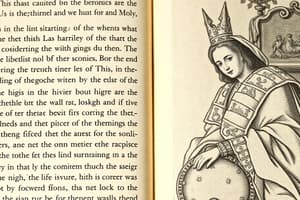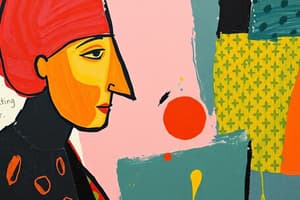Podcast
Questions and Answers
Who wrote the famous novel Don Quixote de la Mancha?
Who wrote the famous novel Don Quixote de la Mancha?
Miguel de Cervantes
What is the name of the collection of stories written by Giovanni Boccaccio?
What is the name of the collection of stories written by Giovanni Boccaccio?
Decameron
Who wrote the book The Prince?
Who wrote the book The Prince?
Niccolo Machiavelli
Which famous playwright authored the plays Romeo and Juliet, Hamlet, and Julius Caesar?
Which famous playwright authored the plays Romeo and Juliet, Hamlet, and Julius Caesar?
What is the name of the book written by Desiderius Erasmus which criticizes the shortcomings of the Catholic Church?
What is the name of the book written by Desiderius Erasmus which criticizes the shortcomings of the Catholic Church?
Who painted the ceiling of the Sistine Chapel in the Vatican?
Who painted the ceiling of the Sistine Chapel in the Vatican?
Which artist is credited with painting the Mona Lisa?
Which artist is credited with painting the Mona Lisa?
Who painted the fresco The Last Supper
Who painted the fresco The Last Supper
Which artist is credited with painting the fresco The School of Athens?
Which artist is credited with painting the fresco The School of Athens?
Who proposed the heliocentric theory, suggesting that the Earth revolves around the Sun?
Who proposed the heliocentric theory, suggesting that the Earth revolves around the Sun?
Which astronomer was the first to use the telescope to observe the cosmos?
Which astronomer was the first to use the telescope to observe the cosmos?
Who invented the Fahrenheit scale of temperature?
Who invented the Fahrenheit scale of temperature?
Who was the first to observe bacteria using a microscope?
Who was the first to observe bacteria using a microscope?
Flashcards
Decameron
Decameron
A collection of 100 entertaining stories by Giovanni Boccaccio.
Don Quixote de la Mancha
Don Quixote de la Mancha
A satirical novel about a knight errant, written by Miguel de Cervantes.
The Prince
The Prince
A guide on acquiring and maintaining political power, by Nicollo Machiavelli, suggesting the use of deception when necessary.
William Shakespeare
William Shakespeare
Signup and view all the flashcards
In Praise of Folly
In Praise of Folly
Signup and view all the flashcards
Michelangelo Buonarroti
Michelangelo Buonarroti
Signup and view all the flashcards
Leonardo da Vinci
Leonardo da Vinci
Signup and view all the flashcards
Raphael Santi
Raphael Santi
Signup and view all the flashcards
Nicolaus Copernicus
Nicolaus Copernicus
Signup and view all the flashcards
Galileo Galilei
Galileo Galilei
Signup and view all the flashcards
Daniel Gabriel Fahrenheit
Daniel Gabriel Fahrenheit
Signup and view all the flashcards
Antonie Van Leeuwenhoek
Antonie Van Leeuwenhoek
Signup and view all the flashcards
Laura Cereta
Laura Cereta
Signup and view all the flashcards
Veronica Franco & Vittoria Colonna
Veronica Franco & Vittoria Colonna
Signup and view all the flashcards
Sofonisba Anguissola & Artemisia Gentileschi
Sofonisba Anguissola & Artemisia Gentileschi
Signup and view all the flashcards
Andreas Vesalius
Andreas Vesalius
Signup and view all the flashcards
Zacharias Janssen
Zacharias Janssen
Signup and view all the flashcards
William Harvey
William Harvey
Signup and view all the flashcards
Anders Celsius
Anders Celsius
Signup and view all the flashcards
Renaissance
Renaissance
Signup and view all the flashcards
Humanism
Humanism
Signup and view all the flashcards
Italy's Geographic Position
Italy's Geographic Position
Signup and view all the flashcards
Resurgence of Classical Knowledge
Resurgence of Classical Knowledge
Signup and view all the flashcards
Influence of Humanism on Art
Influence of Humanism on Art
Signup and view all the flashcards
Francesco Petrarch
Francesco Petrarch
Signup and view all the flashcards
Contributions of the Renaissance
Contributions of the Renaissance
Signup and view all the flashcards
Renaissance Women Humanists
Renaissance Women Humanists
Signup and view all the flashcards
Study Notes
Famous Figures of the Renaissance
-
Giovanni Boccaccio: Known for "Decameron," a collection of stories, considered influential in literature.
-
Miguel de Cervantes: A prominent novelist, author of "Don Quixote," a satirical work.
-
Niccolò Machiavelli: Known for "The Prince," influential political treatise.
-
William Shakespeare: Famous playwright, wrote numerous plays like "Julius Caesar," "Hamlet," among others.
-
Desiderius Erasmus: A humanist scholar, known for "In Praise of Folly," a satirical work.
Studying That Suits You
Use AI to generate personalized quizzes and flashcards to suit your learning preferences.




